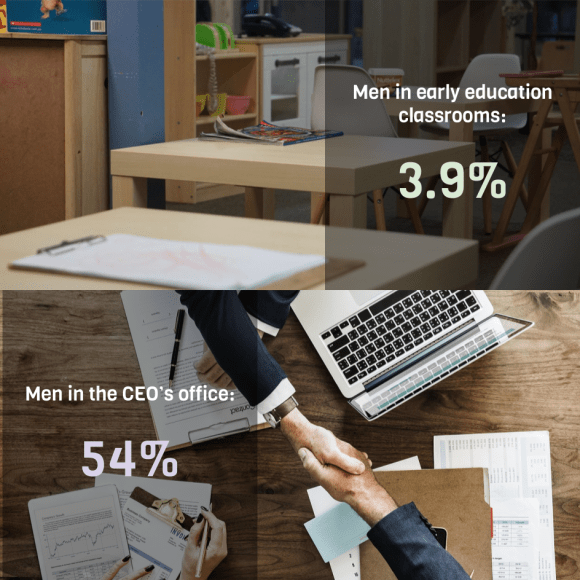Despite only making up 3.9% of the early childhood educator workforce in “long day care” settings, men account for 54% of top leadership roles.
This week, the Early Learning Association Australia announced the appointment of their new CEO, David Worland, replacing outgoing CEO Shane Lucas. You might assume that in a sector that is overwhelmingly dominated by women, Mr. Worland will be one of the few men to take on these kinds of roles. But that is definitely not the case – Mr. Worland will have plenty of male company.
According to the most recent ECEC National Workforce Census conducted in 2016, out of the almost 195,000 educators and teachers working in the early education sector, around 7,600 were men.
In the top roles in the sector however, men actually outnumber their female colleagues. Building on analysis that my friend and colleague Lisa Bryant conducted, I looked at 16 of the largest, or most prominent, early childhood organisations and peak bodies, and found that out of the 35 most senior identified positions (usually CEO and Chair of the Board), 19 (or 54%) were held by men.

When comparing representation in senior leadership roles with working as educators directly with children, men are 14 times more likely to be in the CEO’s office than a classroom. This is a staggering 1400% increase in representation.
The statistics do not imply anything about the individuals undertaking these roles, but rather points to a more complex discussion.
The stark difference in representation highlights ongoing gender issues that afflict the sector, with research from the Workplace Gender Equity Agency revealing that female full-time employees in the preschool sector were paid on average 31.9% less than men, compared with a national gender pay gap of 15.3%.
For a sector grappling with issues of low pay and status primarily due to the gendered nature of the workforce, this must become a topic of action for the sector. Why are women so under-represented in the senior leadership roles of the sector, when compared with their overwhelming representation in educator roles?
One place we could start would be looking at what organisations value in senior leadership roles. While looking at the people in these roles, one factor that really stood out was how few had early education backgrounds and experience. Backgrounds in community services, health and finance featured far more prominently.
As we prepare for International Women’s Day tomorrow, the sector would do well to look closely at our own leadership structures, career progressions and high-level decisions around representation. We can start by celebrating organisations that have promoted and appointed women into these leadership roles, of which there are many in our sector.
But as a sector, we need to decide whether it’s OK that the women we work with as educators every day can’t see a clear pathway from the Staff Room to the Boardroom.
The list of organisations that were analysed for this post can be found here.
